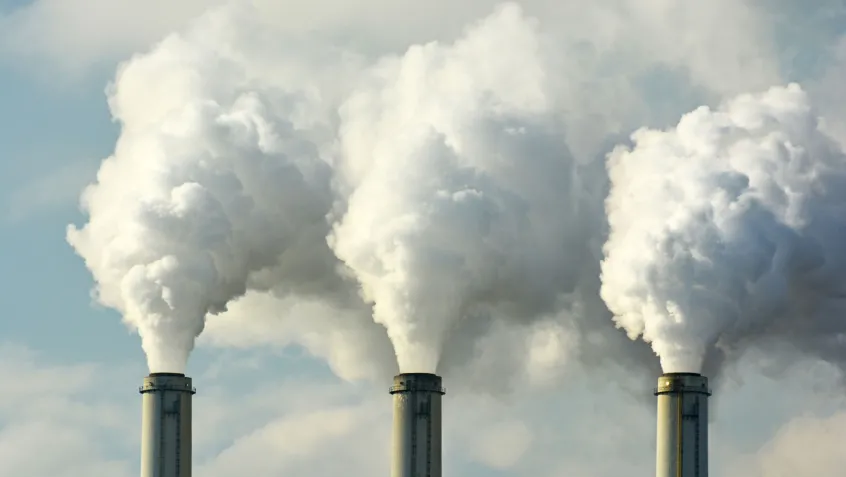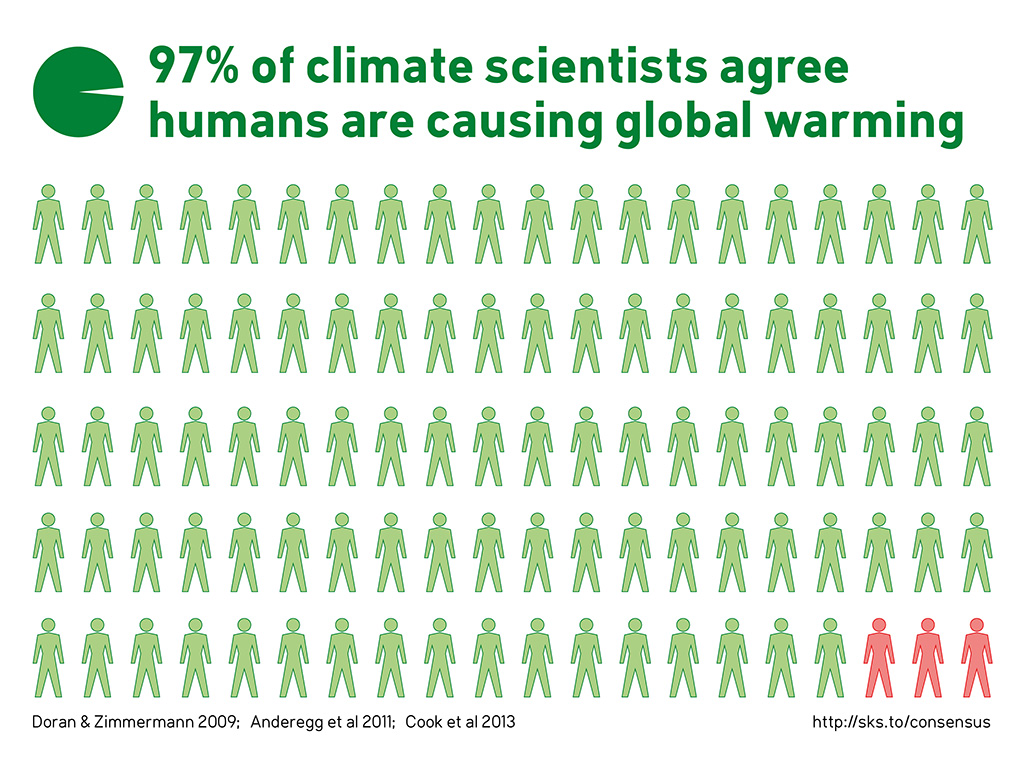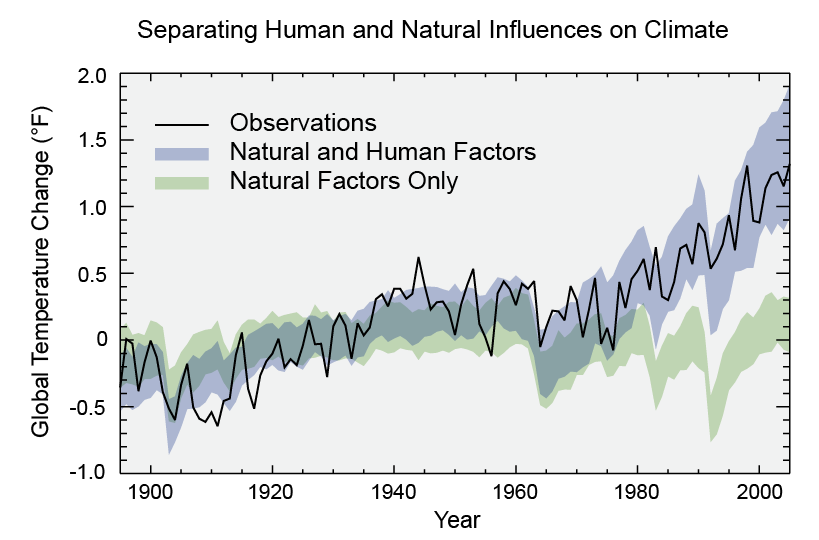
Evidence resulting from sophisticated “bookkeeping” and “fingerprinting” research techniques convinces the scientific community that it is “extremely likely” that human activities are the primary cause of global warming of Earth's atmosphere since the middle of the last century.
The word “consensus” is unusual and, when misused, potentially controversial in the sciences. Serious scientists cherish and embrace notions of well-founded uncertainty, and they spend their workdays “ and in academic institutions their pursuits of tenure “ tilling the fields of uncertainty. American Institute of Physics author and historian Spencer R. Weart, author of the indispensable The Discovery of Global Warming, makes this point decisively in very few words: “Research by definition is done at the frontier of ignorance.”
There is, after all, always the possibility, however remote, of some new scientific theory upsetting a long-standing applecart, just as Galileo did some five centuries ago in placing the Sun, and not our Earth, at the center of our solar system. But for every Galileo, there are a thousand charlatans and “wannabes,” scientists point out. And until the Sun miraculously begins rising in the west, they'll go on accepting the evidence-based theory that it rises in the east and will continue to do so.
There are in fact scientific consensuses in a number of areas, from the gravitational field to the links between tobacco smoking and the incidence of lung cancer.
- Strong Consensus: Earth is Warming and Humans Play a Role
- Further Evidence in Differing Isotopes of ˜Three Flavors' of Carbon
- Understanding the Emphasis on CO2 as a Greenhouse Gas
- References and Resources
Strong Consensus: Earth is Warming and Humans Play a Role
There is an analogy too in the field of climate science: Repeated analyses have shown that an overwhelming majority of scientists in the field“ 97% is the most common estimate “ have concluded that Earth's atmosphere has warmed markedly over the past six decades and that human activities are responsible for a substantial part of that warming. Among scientists, those two points are not the least bit controversial, but rather are seen as part of the physics- and evidence-based reality.

It is important to acknowledge that the scientific consensus on those two points Earth is warming and humans play a significant role in that warming may unsettle some. But the scientific evidence speaks clearly that human activities, and in particular combustion of fossil fuels, rather than natural factors such as solar radiation or volcanic eruptions, are responsible for the observed global temperature increases over land and sea during the past six decades.
If only it weren't so, one might say. But the scientific evidence is what it is, and in this case it's compelling.
Still, it's not so surprising that people may mistakenly assume that natural variations could account for the warming that has been observed globally over the past six decades. Short-term fluctuations such as El Niño and La Niña, after all, lead to short-term natural warming and cooling respectively. Both are known to be factors in substantial year-to-year temperature changes and rainfall differences in the U.S. and around the world. But the National Academy of Science's National Research Council says those resulting “up-and-down fluctuations are smaller than the 20th century warming trend.”
And when scientists look at Earth's atmosphere since around the middle of the 20th century, they find what the Intergovernmental Panel on Climate Change's (IPCC) 2013 Fifth Assessment Report (AR5) describes as “unequivocal” evidence that natural factors alone, such as the influence of major eruptions like that in 1991 at Mount Pinatubo in the Philippines, cannot explain the global temperature increases. In their extensive research, scientists factor out the role of anthropogenic, or human-caused, radiative forcings and factor out, in particular, the influence of greenhouse gases such as carbon dioxide. But with the impacts of those greenhouse gases zeroed out, the scientists cannot explain the observed higher temperatures.
The results led the IPCC to conclude in 2013 in its Fifth Assessment Report that it is “extremely likely,” with a 95% level of confidence, that humans are playing a significant role in the warming. In science, it just doesn't get much more “certain” than that.
It comes down to this: No greenhouse gases means no way to explain the observed (and not simply modeled) increase in global temperatures. If one denies the influence of the greenhouse gases, one must then offer up a scientifically credible and vetted alternative cause, and no one has done so.

Further Evidence in Differing Isotopes of 'Three Flavors' of Carbon
But there's more still, and it comes down to a question of understanding the specific isotopes associated with carbon.
In his 2011 book and PBS documentary of the same name, Earth: The Operators' Manual (ETOM), National Academy of Sciences Member Richard B. Alley, a climatologist at Penn State University, wrote, “You would need to be a real believer in coincidences to imagine that the recent change [in atmospheric concentrations of carbon dioxide, CO2] is natural, and that after two million years nature decided to crank up CO2 just exactly at the time that humans got serious about burning fossil fuels.”
But forget about coincidences, he continued: “Simple bookkeeping” and “fingerprinting” of carbon provide evidence of humanity's role in the warming. The first step involves measuring how much oil, coal and natural gas we are burning how many oil tankers and coal trains and how much CO2 results. That's not a difficult set of calculations to make, it turns out, and Alley explains that the amounts involved “are not hugely uncertain.” In addition, modern volcanoes have emitted only 1 to 2% of the CO2 emissions resulting from combustion of fossil fuels, also negating the potential role they might have played as major contributors to the warming.
The evidence further shows that it's not releases of CO2 from the world's oceans that are causing the warming, and the logic here is pretty simple: the oceans are gaining, and not losing, CO2, and in the process becoming more acidic.
The forensic science on this issue really gets interesting in analyzing what Alley refers to as the “three flavors” of carbon. In his words from ETOM:
"Carbon comes in three flavors: the very rare and radioactive carbon-14 that is made by cosmic rays and decays away in about 40,000 years, and the relatively rare carbon-13 and much more common carbon-12, both of which are stable. Plants take in at least a little of all three, but 'prefer' the easier-to-use carbon-12 and so have a slightly higher ratio of carbon-12 to carbon-13 than is found in shells or volcanoes. Living and recently dead plants include some carbon-14, but all of it has decayed before plants are converted to fossil fuels, or before plants or shells or other things are taken deeply enough in Earth to feed an erupting volcano. As CO2 levels in the air have increased since the Industrial Revolution began, carbon-12 has become more common in the atmospheric CO2 and carbon-14 less common. Volcanoes melt a lot of shells to make CO2, but melting doesn't use oxygen whereas burning does, and we see the drop in oxygen that corresponds to the rise in CO2. Hence, the atmospheric shift toward CO2 is coming from the burning of long-dead plants, beautifully confirming the bookkeeping."
“It's us,” Alley said in the PBS documentary in summarizing those results. Watch the video:
(*See Editor's Note below.)
Understanding the Emphasis on CO2 as a Greenhouse Gas
If only the “pollutant” in the case of the warming climate were something other than carbon dioxide, some might say, which in addition to being odorless, colorless and invisible, is of course critical to life on Earth at the right amounts and concentrations. But it's a case in which too much of a good thing is a bad thing.
The potential economic, socio-economic, political and other implications of an effort to reduce carbon dioxide emissions and concentrations certainly would be expected to be much less far-reaching if the “culprit” were a true villain, one with no redeeming merits and one for which a range of suitable substitutes or alternatives might readily exist.
That's just not the case with CO2, and as a result it is routinely considered to be the most important of the greenhouse gases with respect to human-induced climate change since preindustrial times. Why? It's not nearly so abundant in the atmosphere as, for instance, water vapor, itself a major greenhouse gas (GHG). And molecule for molecule it's not nearly so voracious a greenhouse gas as methane or some of the chlorofluorocarbons. Yet it's the single greenhouse gas considered indispensable to any serious and comprehensive long-term climate change risk management strategy.
Three points briefly explain the rationale here:
1. Since preindustrial times, in terms of watts per square meter of radiative forcing, the effect of the observed increase in atmospheric carbon dioxide far exceeds that of the other greenhouse gases as a cause of Earth's warming climate. (See IPCC graphic on this point.)
The term radiative forcing involves differences between the net incoming solar radiation energy and outgoing infrared radiation energy. That difference causes the planet's overall radiative balance to depart from its normal state, leading to changes in temperature. Positive radiative forcing leads to surface warming, and negative radiative forcing leads to cooling.
Describing the relative roles of changing atmospheric greenhouse gases levels in warming, a panel of scientists reporting to the Intergovernmental Panel on Climate Change summarized things this way: "The largest contribution to total radiative forcing is caused by the increase in the atmospheric concentration of CO2 since 1750."
And they summarize changes over the most recent decade as follows: "The most recent decadal increase in radiative forcing is attributable to CO2 (56%), CH4 [methane] (11%), N2O [oxides of nitrogen] (6%) and CFCs [chlorofluorocarbons] (24%), stratospheric H2O [water vapor] is estimated to have contributed 4%."
2. Water vapor and carbon dioxide are both greenhouse gases that absorb infrared radiation energy. Without them, our planet would be a much colder place. Water vapor is considered the largest contributor to the natural greenhouse effect, whereas changes in CO2 concentrations since preindustrial times make carbon dioxide the largest contributor to the anthropogenic (human-made) greenhouse effect.
However, unlike water vapor, which by sheer volume dwarfs the concentrations of carbon dioxide in the atmosphere, CO2 is itself a primary driver of human-induced warming. In contrast, the global atmospheric water vapor content is largely controlled by temperature, with the water vapor holding capacity of air increasing as temperatures rise. So, CO2-induced atmospheric warming can in turn lead to increased water vapor in the atmosphere, which in turn leads to additional warming“ a process referred to as a climate feedback. Similarly, if one could dramatically reduce CO2 concentrations in the atmosphere, the atmosphere would cool, leading to lower levels of water vapor and an amplification of the initial CO2-induced cooling. The physics here can be stated fairly simply: Higher concentrations of CO2 increase warming of the atmosphere, and the warmer atmosphere retains more water vapor, up to the point that it is released as precipitation. In effect, the water vapor is regularly washed-out of the atmosphere, and generally in short order.
3. CO2, unlike, for instance, methane or black carbon, is extremely long-lived in the atmosphere: it has a “long tail” and the impacts of emissions released today can endure for hundreds of years.
An effective residence time for CO2 in the atmosphere has been estimated to be centuries, whereas methane's is closer to one decade and black carbon' s residence time is measured in days. (A worthwhile FAQ document on this issue “ How long does it take for the oceans and terrestrial biosphere to take up carbon after it is burned?“ is available from Oak Ridge National Laboratory's Carbon Dioxide Information Analysis Center.)
It's the combination of longevity, potency as a greenhouse gas and increasing concentrations that gives CO2 its top standing among GHGs. The National Academies, in its Climate Stabilization Targets: Emissions, Concentrations, and Impacts over Decades to Millennia Report in Brief, puts it this way:
Carbon dioxide flows into and out of the ocean and biosphere in the natural breathing of the planet, but the uptake of added human emissions depends on the net change between flows, occurring over decades to millennia. This means that climate changes caused by carbon dioxide are expected to persist for many centuries even if emissions were to be halted at any point in time.
Such extreme persistence is unique to carbon dioxide among major agents that warm the planet. Choices regarding emissions of other warming agents, such as methane, black carbon on ice and snow, and aerosols, can affect global warming over coming decades but have little effect on longer-term warming of the Earth over centuries and millennia. Thus, long-term effects are primarily controlled by carbon dioxide.
Finally, the salience of carbon dioxide as the principal contributor to atmospheric warming does not mean that the other greenhouse gases can be ignored or excluded from an overall long-term risk-based climate change strategy. Focusing on some of those GHGs early can in fact provide nearer-term benefits, mitigate some near-term problems, and in effect, help “buy time” for subsequent approaches. For similar reasons, the global climate models used to develop “what if” projections of how our planet's climate will respond to different potential radiative forcing scenarios simulate the effects of several different radiative forcing agents (e.g., methane, halocarbons, sulfate aerosols, black carbon and other aerosols) and not only carbon dioxide.
The bottom line is that carbon dioxide is the greenhouse gas which, more than any of the others, is seen by the science community as being essential in a long-term strategy, making its inclusion in such an approach essential even while the other GHGs may provide short-term benefits for managing warming.
Editor's Note: Alley's classroom and other lectures (and also YouTube videos and singing) are widely cited as examples of effective climate communications and in 2011 he was personally recognized with a $10,000 award as an outstanding climate science communicator. An example on this very issue of human vs. natural causation is his PBS documentary powerful visual explanation of this carbon isotope evidence. Like many of his other presentations on scientific and technical matters related to Earth and its climate, it's likely to make a lasting impression and its scientific underpinnings have survived widespread scrutiny and peer review.
References and Resources
- Climate Change 2013: The Physical Science Basis: Summary for Policymakers, Working Group I Contribution to the Fourth Assessment Report of the Intergovernmental Panel on Climate Change, 2013, World Meteorological Organization and United Nations Environment Programme.
- The Discovery of Global Warming, Spencer R. Weart, 2008, Harvard University Press.
- The Rough Guide to Climate Change: The Symptoms, The Science, The Solutions, 2011, Robert Henson, Roughguides.com.
- The Thinking Person's Guide to Climate Change, 2014, Robert Henson, AMS Books.
- Earth: The Operators' Manual, Richard B. Alley, 2011, W.W. Norton and Company.
- Skeptical Science.com
- Radiative Forcing of Climate, K.P. Shine, R.G. Derwent, D.J. Wuebbles, J-J. Morcrette, research paper as part of Intergovernmental Panel on Climate Change Fourth Assessment Report, 2007.
- Climate Stabilization Targets: Emissions, Concentrations, and Impacts over Decades to Millennia: Report in Brief, 2010, National Academy of Sciences.
- America's Climate Choices: Informing an Effective Response to Climate Change, National Research Council, 2011, National Academy of Sciences.
About the Author
Morris A. (Bud) Ward, editor of Yale Climate Connections, is a proven and widely experienced communicator and educator on environmental, energy and climate change issues. He has an extensive publishing history including hundreds of bylined news and analysis articles and authorship or co-authorship of five professional books. He has conducted numerous first-hand workshops for reporters, editors and policy makers on issues involving journalism/communications, climate change and environmental risk. He writes, speaks and teaches regularly on issues related to climate change and on the changing nature of journalism and mass communications in modern society.


